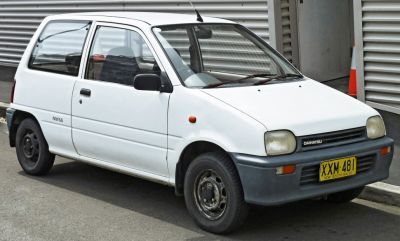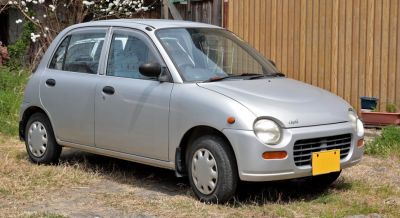 1997 SeAZ 1111 Dimensions, Size & Specs
1997 SeAZ 1111 Dimensions, Size & Specs
Measurements of the 1997 SeAZ 1111, engineered for optimal performance and comfort
| Dimensions | |
|---|---|
| Length: | 3200-3350 mm126.0-131.9 in10.5-11.0 ft |
| Width: | 1420 mm55.9 in4.7 ft |
| Height: | 1400-1415 mm55.1-55.7 in4.6-4.6 ft |
| Trunk Capacity: | 210 liter7.4 cu ft |
| Trunk Capacity (Max): | 650 liter23.0 cu ft |
| Weight Specifications | |
| Curb Weight: | 660-705 kg1455-1554 lbs |
| Maximal permitted Weight: | 985-1015 kg2172-2238 lbs |
| Tire Specifications | |
| Rims Size: | 13-inch rims:
|
| Tire Sizes: |
|
The SeAZ 1111, produced from 1997 to 2008, is a compact Russian hatchback designed primarily for urban driving and efficient space usage. This generation measures between 3,200 mm and 3,350 mm (126 to 132 inches) in length, making it notably short and easy to maneuver in tight city streets. The vehicle's width stands at 1,420 mm (56 inches), which complements its narrow design to enhance agility and parking convenience. Height varies slightly from 1,400 mm to 1,415 mm (55 to 56 inches), offering sufficient headroom for passengers without increasing the vehicle's profile excessively.
In terms of weight, the SeAZ 1111 is very lightweight considering its class. It has a curb weight ranging from 660 kg to 705 kg (1,455 to 1,554 lbs), with a maximum permissible weight of 985 kg to 1,015 kg (2,172 to 2,237 lbs). This lightweight construction contributes to better fuel efficiency and responsiveness on the road.
One of the vehicle’s practical features is its luggage capacity, which provides 210 liters (7.4 cubic feet) of storage space in the standard configuration. When the rear seats are folded down, the cargo volume expands significantly to 650 liters (22.9 cubic feet), allowing for more versatile transport of larger items. This flexibility makes the SeAZ 1111 well-suited for daily errands and small cargo transport.
The SeAZ 1111 is equipped with rims sized 5.5J x 13, supporting tires in various dimensions such as 135/80 R12, 155/70 R13, and 135/80 R13, ensuring adequate road grip and stability despite its compact stature.
Overall, the SeAZ 1111 generation offers a balanced package for those seeking a small, practical hatchback with efficient use of space, capable of handling city driving needs while providing adequate luggage options.
Discover the standout features that make the 1997 SeAZ 1111 a leader in its class
Have a question? Please check our knowledgebase first.
The SeAZ 1111 generation produced from 1997 to 2008 features a compact hatchback design with a length ranging between 3200 mm and 3350 mm (126 to 132 inches), a fixed width of 1420 mm (56 inches), and a height varying between 1400 mm and 1415 mm (55 to 56 inches). These dimensions place the vehicle firmly in the microcar segment, making it suitable for urban environments and tight parking spaces. The slightly variable length accounts for minor model updates or different body configurations during the production years, while the width and height remain stable, emphasizing its compact footprint. This size profile contributes to the car's ease of maneuverability and efficiency, especially in congested city settings.
The SeAZ 1111 from 1997 to 2008 has a curb weight that ranges from 660 kilograms to 705 kilograms (1455 to 1554 pounds). This weight reflects the vehicle when it is empty, including standard equipment and fluids but excluding passengers and cargo. The maximum weight capacity, or gross vehicle weight rating (GVWR), is between 985 kilograms and 1015 kilograms (2171 to 2237 pounds). This rating indicates the maximum allowable total vehicle weight including passengers, cargo, and fuel. The relatively light curb weight contributes to the car’s modest fuel consumption and agile handling, while the maximum weight ensures reasonable carrying capacity for its class.
The luggage capacity of the SeAZ 1111 is designed to accommodate everyday needs and varies depending on the rear seat configuration. With the rear seats in their upright position, the car offers a luggage volume of approximately 210 liters (about 7.4 cubic feet). This space is enough for a few small suitcases, grocery bags, or compact luggage items. When the rear seats are folded down, the luggage capacity significantly increases to about 650 liters (roughly 22.9 cubic feet), allowing for much larger items or more extensive cargo. This flexible storage capacity makes the SeAZ 1111 practical for both daily commuting errands and light cargo transport.
Yes, the SeAZ 1111 fits comfortably into a standard garage. Its compact size—with a maximum length of around 3350 mm (132 inches or 11 feet), width of 1420 mm (56 inches or 4.7 feet), and height up to 1415 mm (56 inches or 4.7 feet)—allows it to easily park in a typical residential garage, which commonly measures at least 6 meters (20 feet) in length and 3 meters (10 feet) in width. The car’s narrow width and short length mean that it leaves sufficient space for opening doors and walking around within standard garages. This suitability makes the SeAZ 1111 an excellent choice for owners looking for a vehicle that is easy to store in urban or suburban home settings.
The SeAZ 1111 is equipped with relatively small rims, sized at 5.5J x 13 inches, which are fitted with tire options including 135/80 R12, 155/70 R13, and 135/80 R13. The smaller rim and tire size contribute to a smoother ride over urban potholes and rough paving, as the higher tire sidewalls provide additional cushioning. These tires also help maintain good traction for a lightweight hatchback on various road surfaces. However, smaller wheels generally mean less precise cornering compared to bigger wheels, but this trade-off is typical in economy cars designed primarily for comfort and efficiency rather than sporty performance. The choice of tire width and profile strikes a balance between stability and ride comfort.
The SeAZ 1111's generation that ran from 1997 to 2008 maintained the compact dimensions characteristic of its predecessor models produced by the SeAZ plant. While exact predecessor dimensions vary slightly depending on model years, the 1111 generation tended to feature marginally increased length—ranging from 3200 to 3350 mm—helping to improve interior space and luggage capacity without sacrificing its microcar qualities. The width at 1420 mm and height around 1400 to 1415 mm remained consistent with or slightly improved over previous versions, maintaining ease of maneuverability. Overall, the 1997-2008 1111 generation subtly enhanced space efficiency and comfort while preserving the vehicle's small, city-friendly footprint.
Compared to similar compact hatchbacks from the 1990s and 2000s, the SeAZ 1111 is notably smaller and lighter. Its length of approximately 3.2 to 3.35 meters (10.5 to 11 feet) is shorter than many contemporaries like the Lada Oka or early Daewoo Matiz models, which typically measured closer to 3.5 meters or more. At 660 to 705 kilograms in curb weight, it is lighter than many hatchbacks that often tipped the scales above 900 kilograms. This makes the SeAZ 1111 a particularly efficient and easy-to-handle vehicle in urban scenarios but with sacrifices in power and space when compared to broader market competitors. Its luggage capacity of up to 650 liters with seats folded is competitive, though interior and safety features are more basic compared to Western or Japanese rivals of the time.
The compact exterior dimensions of the SeAZ 1111 inevitably influence passenger comfort and interior space. Despite its small footprint—length between 3200 and 3350 mm and width at 1420 mm—the car is arranged to maximize space for up to four passengers in a tight but functional cabin layout. Headroom and legroom are adequate for city driving but may be restrictive for taller or larger adults during longer journeys. The limited width and height reflect its design goals centered on urban mobility and economy rather than spaciousness. However, the practical folding rear seats help increase cargo versatility, compensating for interior space constraints. Passengers benefit from easy ingress and egress, but the car is best suited for short trips or city driving rather than extended travel with multiple occupants.
The SeAZ 1111's curb weight, between 660 and 705 kilograms (1455 to 1554 pounds), is relatively low due to several design and engineering factors appropriate for its class and purpose. Firstly, it was designed as an economy hatchback, emphasizing minimalism and cost-effectiveness, leading to the use of lightweight materials and simplified mechanical components. The compact size itself reduces material requirements. Additionally, the vehicle's small engine and limited features contribute to a lower total weight. The lightweight construction enhances fuel efficiency and maneuverability, which is ideal for urban driving conditions. However, this low weight also means that the car may lack some of the rigidity and safety features found in heavier, larger vehicles.
The SeAZ 1111 is equipped with 5.5J x 13-inch rims and can come fitted with tire sizes such as 135/80 R12, 155/70 R13, and 135/80 R13. These relatively narrow and higher-profile tires are designed to suit the vehicle’s lightweight construction, promoting a smoother ride quality by better absorbing road imperfections. The tire sizes provide a balance between grip and rolling resistance, favoring fuel economy and comfort over sporty handling. Larger rim sizes might improve handling but would reduce ride comfort and increase costs. For a compact hatchback emphasizing practicality and city driving, this setup helps maintain a stable, safe feel while keeping maintenance and operating expenses low.
Discover similar sized cars.

| Production: | 1990-1994 |
|---|---|
| Model Year: | 1990 |
| Length: | 3295 mm129.7 in |
| Width: | 1395 mm54.9 in |
| Height: | 1410 mm55.5 in |

| Production: | 1992-1998 |
|---|---|
| Model Year: | 1992 |
| Length: | 3295 mm129.7 in |
| Width: | 1395 mm54.9 in |
| Height: | 1395 mm54.9 in |

| Production: | 1989-1998 |
|---|---|
| Model Year: | 1990 |
| Length: | 3290 mm129.5 in |
| Width: | 1395 mm54.9 in |
| Height: | 1400-1425 mm55.1-56.1 in |

| Production: | 1992-1998 |
|---|---|
| Model Year: | 1992 |
| Length: | 3295 mm129.7 in |
| Width: | 1395 mm54.9 in |
| Height: | 1375-1385 mm54.1-54.5 in |
